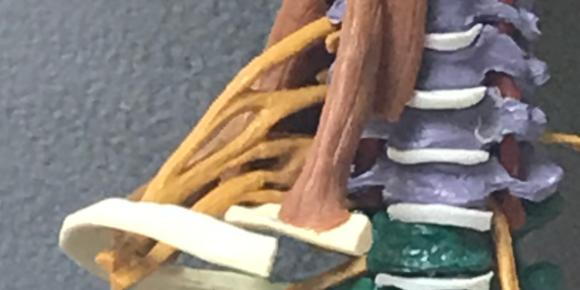
- posted: Jul. 16, 2020
Thoracic Outlet Syndrome (TOS) is a condition that we frequently treat in our office. This condition is characterized by upper extremity pain or paresthesia caused by occlusion, compression, injury or irritation to the neurological or vascular structures of the thoracic outlet.
Causes of Thoracic Outlet Syndrome:
Thoracic outlet syndrome is generally a mechanical problem, but there are two potentially threatening vascular causes that should be ruled out. Arterial Thoracic Outlet Syndrome is caused by pressure of the subclavian artery from stenosis, aneurysm, embolus, or compression from a cervical rib or an abnormal first rib. It is the most serious cause of TOS but is also the least common. Arterial Thoracic Outlet Syndrome generally accounts for less than 1% of cases. Symptoms of arterial Thoracic Outlet Syndrome generally include, coldness, weakness, arm fatigue, and arm pain.
Venous Thoracic Outlet Syndrome is caused when there is obstruction of blood flow to the subclavian vein. This type of Thoracic Outlet Syndrome generally makes up less than 5% of all Thoracic Outlet cases. Symptoms of Venous TOS include edema (swelling), cyanosis (poor blood flow, causes skin discoloration). .
Most of TOS patients suffer from what is called Neurogenic Thoracic Outlet Syndrome. This is when the neurovascular bundle is compressed. Neurogenic TOS includes 3 primary sites of compression.
Anterior and Middle Scalene muscle compression
Pectoralis Minor Tendon Compression
First Rib and Clavicle Compression
Risk Factors for TOS:
Congenital Anomalies-Such as an additional rib in the cervical spine known as a Cervical Rib.
Poor Posture-Slouching decreasing the space in this region, causing an increased risk for compression. Static postures such as those required by computer users, assembly line workers, supermarket checkers, and students, predispose to TOS.
Lifestyle Habits-If a person performs a lot of prolonged overhead activities, that will increase a person's risk of developing Thoracic Outlet Syndrome. For example: electricians, painters, swimmers, volleyball players, tennis players, and baseball pitchers are at risk for developing Thoracic Outlet Syndrome.
Other Thoracic Outlet Facts:
Most patients presenting with TOS are between the ages of 20-60
TOS is more common in women with some estimates as high 9:1 vs men.
How we treat Thoracic Outlet Syndrome:
If we determine that there is not the absence of acute or threatening neurovascular problems, conservative care should be the treatment of choice for TOS. The treatment pathway for TOS is based upon the specific site(s) of neurovascular compression, but TOS is often multifactorial in origin and successful management needs to address each component.
Joint manipulation may be indicated for restrictions:
Cervical spine
First rib
Cervicothoracic junction
Shoulder
Elbow
Hand and Wrist.
Stretching and myofascial release techniques addressing problems in the:
Cervical spine
Scalenes
Pectoral muscles
distal sites of potential "double crush" involvement, i.e., cubital tunnel, carpal tunnel, wrist flexors, etc.
Postural modification is important in our treatment plans. Our doctors often prescribe lifestyle, which includes avoidance of repetitive postural stress and workstation modification. We often recommend that our patients avoid carrying heavy loads, especially on their shoulder. Avoid carrying carpet rolls, briefcases, laptop cases or heavy shoulder bags. You should considered lightening the carried items. For women, bra straps may need additional padding or consideration of replacement with a sports bra.
If you are experiencing pain or numbness and tingling down the arm call our office at 504-456-9296, and see how our doctors can help you.
HOURS OF OPERATION
Same Day Service
8:30 am - 6 pm
9 am - 5 pm
8:30 am - 6 pm
9 am -12 pm
8:30 am - 5 pm
9 am - 12 pm
Closed
Location
Find us on the map
Provance Chiropractic Sports & Wellness, LLC
2920 Kingman St STE 110
Metairie, LA 70006, US
(504) 456-9799
